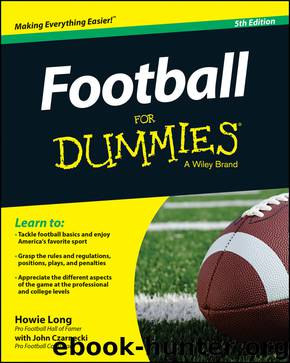Football For Dummies by Howie Long

Author:Howie Long
Language: eng
Format: epub
ISBN: 9781119022640
Publisher: Wiley
Published: 2015-05-18T00:00:00+00:00
Football teams employ two types of pass coverage: man-to-man coverage and zone coverage. Both coverages have many variations and combinations, but the core of every coverage begins with either the man-to-man concept or a zone concept. I get you familiar with the core coverages first, and then I show you some of the variations.
Man-to-man coverage
Simply stated, man-to-man coverage is when any defensive back, or maybe even a linebacker, is assigned to cover a specific offensive player, such as a running back, tight end, or wide receiver. The defender must cover (stay with) this player all over the field until the play ends. His responsibility is to make sure the receiver doesn’t catch a pass. The most important rule of man-to-man coverage (which is also known as man coverage) is that the defensive back must keep his eyes on the player that he’s guarding or is responsible for watching. He’s allowed to take occasional peeks toward the quarterback, but he should never take his eyes off his man.
Here are the three main types of man-to-man coverage:
Man free: In this coverage, all defensive backs play man-to-man coverage except the free safety, who lines up or drops into an area and becomes a safety valve to prevent a long touchdown completion. This style of coverage is used when the defense blitzes, or rushes four or five players at the quarterback. So, man free is man-to-man coverage with one roaming free safety. Linebackers also cover running backs or even tight ends man-to-man.
Straight man: The free safety doesn’t serve as a safety valve in this alignment — or, as coaches say, no safety help is available. Each defender must know that he (alone) is responsible for the receiver he’s covering. The phrase “the player was stuck on an island” refers to a cornerback being isolated with an offensive receiver and having no chance of being rescued by another defensive back. This style of man-to-man coverage is generally used when the defense is blitzing or rushing a linebacker toward the backfield, hoping to sack the quarterback. Defenses use it depending on the strength and ability of their own personnel and the receiving talent of the offense they’re facing. So, straight man is pure man-to-man coverage with no roaming free safety.
Combo man: This category contains any number of combinations of man-to-man coverage. For example, when a team wants to double-team a great wide receiver (with two defensive backs), it runs a combo man defense. A great receiver is someone like Jerry Rice, who owns virtually every pass-receiving record in the history of pro football. The object of such a defense is to force the quarterback to throw the football to a less-talented receiver than someone like Rice (namely, anybody but him!).
In Figure 10-5, the cornerback (CB) is responsible for the star receiver’s outside move, while the safety (S) is prepared in case the star receiver decides to run his route inside, or toward the middle of the field. A team’s pass defense may be vulnerable on the side of the field opposite where it’s double-teaming a receiver.
Download
This site does not store any files on its server. We only index and link to content provided by other sites. Please contact the content providers to delete copyright contents if any and email us, we'll remove relevant links or contents immediately.
Relentless: A Memoir by Julian Edelman(1767)
The Source by James A. Michener(1510)
Cristiano Ronaldo: The Biography by Guillem Balague(1490)
ALEX FERGUSON My Autobiography by Alex Ferguson(1461)
1942 by Winston Groom(1433)
Football's Strangest Matches by Andrew Ward(1414)
When Pride Still Mattered by Maraniss David(1337)
Time's Champion by Time's Champion (Craig Hinton & Chris McKeon)(1233)
Chiefs by Stuart Woods(1232)
Where Men Win Glory: The Odyssey of Pat Tillman by Jon Krakauer(1153)
Gunslinger by Jeff Pearlman(1143)
0.721 by Gary Webster(1126)
Paterno by Joe Posnanski(1097)
Texas Monthly On… by Texas Monthly(1062)
Snake by Mike Freeman(1061)
Coming Back Stronger by Drew Brees & Drew Brees(1056)
League of Denial by Mark Fainaru-Wada(1031)
Deal Breaker by Harlan Coben(1030)
It Takes What It Takes by Trevor Moawad(1018)
